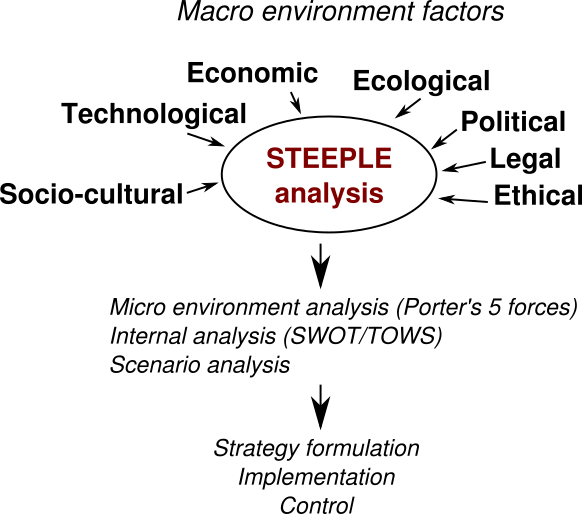STEEPLE analysis
STEEPLE analysis is one variant of the very popular and simple strategic management method for analysis of external environment of the organization. It is based on PEST analysis method, with addition of additional Environmental, E thical and L egal factors. It has other variants, which only have different order of factors: SLEPT analysis, PESTLE analysis and PESTEL analysis. In PESTLED analysis additional Demographic factor is added.
Contents
- 1 Main factors of STEEPLE analysis
- 2 STEEPLE analysis example
- 3 STEEPLE analysis applications
- 4 Advantages and disadvantages of STEEPLE analysis
- 5 References
Main factors of STEEPLE analysis
Five external factors influencing organization is considered:
- S ocio-cultural - social forces influence our attitudes, interests, opinions, moreover create our behavior and ultimately what we purchase. Trends’ changes have correspondingly direct impact on enterprises. These factors contain: structure of population, falling rates, competition, increase of global population, traditions, level of education, cultural diversity and standards. More examples of Social and cultural factors affecting business.
- T echonological - technological advances have greatly changed the manner in which businesses operate. Nowadays technological progress created a society which expects instant results. Here we can mention: new technologies, absorptive capacity for innovation, globalization. New technologies shorten Product life cycle and increase demand for new products. This revolution has increased the rate at which information is exchanged between stakeholders. A faster exchange of information can benefit companies as they are able to react quickly to changes. More examples of Technological factors affecting business.

Fig. 1. Place of STEEPLE analysis in strategic management process
- E conomic - national interest rates and fiscal policy is set around economic conditions, besides has influence on purchasing power of consumers and structure of their expenditure. These factors include: gross domestic product (GDP) creating by demand, stock quote, currency rate fluctuations, rate of inflations, market substitutive and complementary, tax policy, price changes, revenues, savings and level of unemployment. More examples of Economic factors affecting business.
- E nvironmental - environmental protection legislation, pollution, waste management and disposal, clean air and water, energy saving technologies, attitudes towards ecology in society. More examples of Ecological factors affecting business,
- P olitical - factors could create plenty of advantages and opportunities for organizations. These factors include: political situation, political stability, state interference, market regulations, trade agreements, tariffs or restrictions, taxes, lobbying and clarity of law. More examples of Political factors affecting business,
- L egal - (subset of above mentioned political factors) involve all regulatory and law determinants that can negatively or positively affect results of market actions and decisions of management of company functioning in particular country. International companies must analyze and identify those factors (legal environment) independently for every state they function. More examples of Legal factors affecting business.
- E thical factors involve duties, morality, integrity, behaviour, what is good and bad for company, employees and society as a whole. More examples of Ethical factors affecting business.
Above mentioned external environment factors, can have both positive influence (then they are called opportunities) or negative influence (and then they are called threats).
STEEPLE analysis example
A STEEPLE analysis example would be for a company that is planning to enter the electric vehicle market.
- SOCIAL: The increasing concern for environmental issues and the desire for sustainable transportation options has led to a growing demand for electric vehicles.
- TECHNOLOGICAL: Advancements in battery technology and charging infrastructure have made electric vehicles more practical and convenient for consumers.
- ECONOMIC: Electric vehicles tend to have higher upfront costs than traditional gasoline vehicles, but they can offer significant cost savings over time through lower fuel and maintenance costs.
- ENVIRONMENTAL: Electric vehicles produce significantly lower emissions than traditional gasoline vehicles, which is a positive impact on the environment.
- POLITICAL: Government incentives and regulations in some countries promoting the use of electric vehicles and the phasing out of internal combustion engines, which creates a supportive environment for the electric vehicle market.
- LEGAL: There are regulations and standards that electric vehicles must meet, such as emissions standards and safety requirements.
- ETHICAL: Electric vehicles are considered to be more ethical than traditional gasoline vehicles because they produce fewer emissions and have a smaller environmental impact.
Based on this analysis, the company may conclude that the electric vehicle market offers significant opportunities for growth and may develop strategies to take advantage of these opportunities, such as investing in battery and charging technology research, partnering with governments to promote the use of electric vehicles and working to lower the upfront cost of electric vehicles to make them more accessible to consumers.
STEEPLE analysis applications
STEEPLE analysis can be used in a variety of contexts and for different purposes, including:
- Strategic planning: STEEPLE analysis can be used to inform strategic planning and decision-making by identifying potential opportunities and threats in a market or industry.
- Marketing: STEEPLE analysis can be used to inform marketing strategies by identifying trends and patterns in consumer behavior and the broader market.
- Business development: STEEPLE analysis can be used to identify potential growth areas and opportunities for expansion.
- Industry analysis: STEEPLE analysis can be used to gain a better understanding of an industry and the external factors that can impact it.
- New venture creation: STEEPLE analysis can be used to evaluate the feasibility of new business venture, by assessing the external factors that can impact it.
- SWOT analysis: STEEPLE can be used as a tool to complete SWOT analysis, where SWOT stands for Strengths, Weaknesses, Opportunities and Threats.
Overall, STEEPLE analysis can be used when an organization or company wants to gain a better understanding of the external factors that can impact its operations, and to develop strategies to respond to those factors.
Advantages and disadvantages of STEEPLE analysis
Advantages of STEEPLE analysis:
- Comprehensive: STEEPLE analysis looks at a wide range of external factors that can impact an organization or industry, providing a more complete and holistic view of the market or industry.
- Strategic planning: STEEPLE analysis can help organizations identify potential opportunities and threats, which can inform strategic planning and decision-making.
- Identifying trends: STEEPLE analysis can help organizations identify emerging trends and patterns in the market or industry, which can inform future strategies and plans.
- Easy to understand: STEEPLE analysis is simple to understand and can be used by organizations of all sizes and types.
Disadvantages of STEEPLE analysis:
- Time-consuming: Conducting a STEEPLE analysis can be time-consuming and may require a significant investment of resources.
- Limited focus: While STEEPLE analysis looks at a wide range of external factors, it may not provide a detailed analysis of specific issues or trends.
- Limited perspective: STEEPLE analysis is based on external factors, it may not take into account internal factors that can impact an organization or industry.
- Limited actionability: While STEEPLE analysis can help organizations identify potential opportunities and threats, it may not provide clear guidance on how to respond to those factors.
| STEEPLE analysis — recommended articles |
| STEEP analysis — PEST analysis — Macro environment analysis — Factors affecting business — Opportunities and threats — External analysis — Industry environment — Examples of opportunities — Environmental factors affecting business |
References
- Bowman, C. (1998). Strategy in practice (p. 201). Prentice Hall Europe.
- Pearce, J. A., Robinson, R. B., & Subramanian, R. (2000). Strategic management: Formulation, implementation, and control. Columbus, OH: Irwin/McGraw-Hill.
Author: Krzysztof Wozniak

